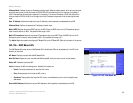
62
Chapter 5: Using the Web-based Utility for Configuration
Security Tab - Storm Control
WebView Switches
Trap Frequency. Defines the time period by which traps are sent to the host. The Trap Frequency (1-1000000)
field can be defined only if multiple hosts are disabled. The default is 10 seconds.
The table contains the following additional fields:
Status. Indicates the host status. If there is an asterisk (*), the port is either not linked or is down. The possible
field values are:
Number of Violations. Indicates the number of packets that arrived on the interface in single-host mode, from a
host whose MAC address is not the supplicant MAC address.
Security Tab - Storm Control
Port. Displays the port number for which storm control is enabled.
Broadcast Control. Indicates whether broadcast packet types are forwarded on the specific interface.
Mode. Specifies the Broadcast mode currently enabled on the device. The possible field values are:
• Unknown Unicast, Multicast & Broadcast. Counts Unicast, Multicast, and Broadcast traffic. This option
is not available on the SRW224G4 and SRW248G4.
• Multicast & Broadcast. Counts Broadcast and Multicast traffic together.
• Broadcast Only. Counts only Broadcast traffic.
Rate Threshold. The maximum rate (packets per second) at which unknown packets are forwarded. The default
value is 3500. The range is 70 -100000.
QoS
Network traffic is usually unpredictable, and the only basic assurance that can be offered is best effort traffic
delivery. To overcome this challenge, Quality of Service (QoS) is applied throughout the network. This ensures that
network traffic is prioritized according to specified criteria, and that specific traffic receives preferential
treatment. QoS in the network optimizes network performance and entails two basic facilities:
Classifying incoming traffic into handling classes, based on an attribute, including:
• The ingress interface
• Packet content
Figure 5-34: Security - Storm Control


















